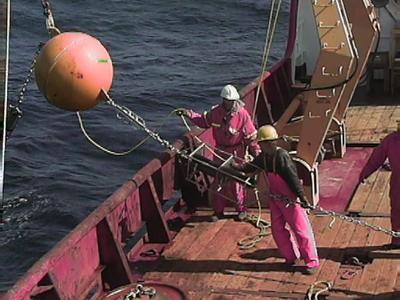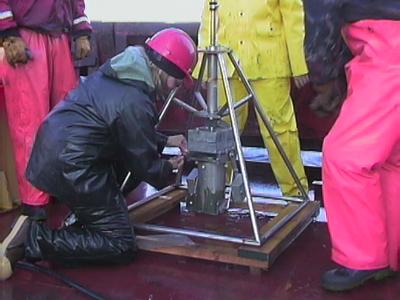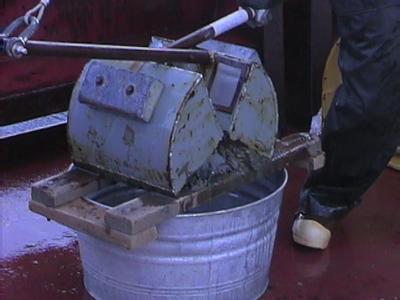14 July, 2003
A Full Day of Science
Our workday began a little before nine in the morning with the
arrival at our first stop of the day. SLIP-I, as the survey station
is referred to, is located at Latitude North 62.013 degrees and
Longitude West -175.056 degrees where the Bering Sea is about 82
meters in depth. A somewhat choppy morning made for a queasy feeling
at breakfast but only lasted until I walked out on deck into the cool
air of a Bering Sea morning. Besides, there was a lot of science to
be done today and no time to feel ill.
Yesterday was a light day with only the deployment of a single CTD.
The better part of my day was working with the ship's technology
person working out "bugs" in my computer to send and receive e-mails
directly. Today promised to be very busy and exciting from the
moment the sea rolled me out of bed and challenged me to take my
shower as the ship rocked back and forth.
SLIP-I involved a CTD deployment, 5 van Veen sediment grabs and 3
HAPS cores. A van Been grab is an instrument that is similar to the
carnival crane games where you have to use a small crane like device
to grab a prize. Only in our case the prize is a bucket of sediment
from the bottom of the sea.
The van Veen grab is gently lowered to the bottom. The bottom contact
trips a weighted trigger that closes the grab bucket while the device
is slowly raised. The buckets contents are then poured into a screen
sieve to be washed and collected for later analysis. The four
consecutive grabs give a one-meter square representation of the areas
benthic biomass.
The next instrument deployed is a HAPS single hole corer that
resembles an open-sided pyramid with a metal cylinder in the center
and a weighted spatula like device on the side. The HAPS corer is
lowered to the bottom. Once on the bottom the weights "push" the
metal cylinder through the sediment triggering the spatula like
device to slam down and over the bottom of the cylinder thus trapping
the collected core sample. The instrument is then raised to the
surface and the sample is removed for analysis.
Both the core sampling and the sediments grabs are primarily part of
the research that is being conducted by our Chief Scientist, Dr.
Jackie Grebmeier. Her research involves the study and changes within
the benthic, or bottom, community in this region. Studies have shown
a reduction in some of the benthic organisms and those creatures that
feed on them over the past several years. Another part of today's
schedule was the deployment of a subsurface mooring in 78 meters of
water between SLIP-I and SLIP-2 survey stations. The mooring array
consists of weights chained to the bottom and several instruments
spread out along a suspended chain. This parcticular mooring consists
of 16 instruments measuring temperature, salinity, current,
chlorophyll and nutrients in the water. Bobber like ballasts keep the
whole mooring suspended from the sea bottom but well below shipping
traffic. Next year the mooring will be retrieved and replaced.
The data collected during the year will be used to look at
fluctuations and changes during the year in this region. My primary
job today was assisting with the van Been grabs and screening the
sediment. This was actually quite interesting because as you gently
hosed away the mud you never knew what was going to appear, brittle
stars, bivalves, tubeworms, crab, fish, snails and all sorts of other
surprises. We completed four stations sites today. The final one at
3:00 in the morning in the cold, wind and rain. As one crew member
smiled a remarked, "Anything for science!" As I diligently screened
sea mud at the last station I couldn't help to think how this scene -
four muddy, wet, cold, rain gear clad adults, washing mud through
screens at 3:00 in the morning, on a ship, in the middle of the
Bering Sea, would make an excellent coffee commercial. I can smell
the endorsements now, or maybe it's the rotten egg smelling mud, at
this hour I can't be sure.
After I de-mudded (new science term) I found myself too tired to
sleep. It was still fairly light out so I sat down on the helicopter
pad and watched the sea fog roll in as the ship's engines once again
churned back to life, advancing the ship northward, bobbing up and
down to an unheard maritime lullaby that eventually rocked me to
sleep.

Deployment of the buoy.

Dr. Grebmeier with HAPS corer.

Successful mud grab.
Contact the TEA in the field at
.
If you cannot connect through your browser, copy the
TEA's e-mail address in the "To:" line of
your favorite e-mail package.
|
